12 Easy-Prep Sunday School Games: If you teach Sunday School, you need Sunday school games that your kids will love.
You need exciting, active, kid-friendly classroom lesson review games that you can pull together quickly, that don’t require tons of expensive supplies, and that will keep your students engaged.
Here are 12 super-fun, easy-prep Sunday school games your students will love. Each of these Bible lesson games can be used with questions from the Bible lesson that you are currently teaching. These classroom review games are are sure to add some excitement to your class.
Best part? Once you find 5 or 6 of these Sunday School games that your class loves, you can keep the supplies on hand, rotate through those games, and never have to wonder what you will do with your kids in Sunday school each week. Good bye to the Saturday night blues!
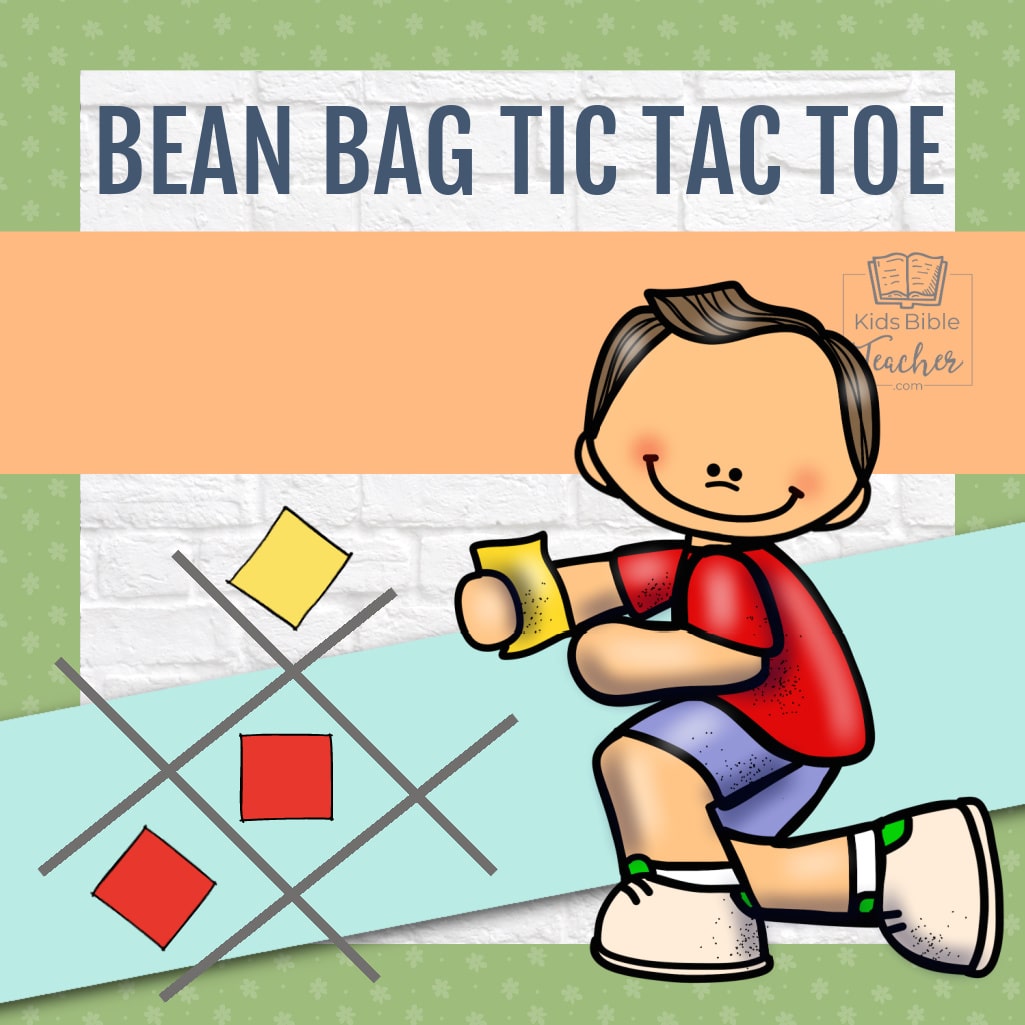
1. Bean Bag Tic Tac Toe Lesson Review Game
Ages: 1st grade and up
Materials Needed:
- List of Review Questions from your Bible lesson (at least 12 questions!)
- Masking Tape
- 10 Small Bean Bags, 5 marked with an “X” in permanent mark on both sides and 5 blank bean bags. You could also play this game with bean bags in two different colors.
Set up: Use four long pieces of masking tape to make a Tic Tac Toe pattern on the floor, creating three columns by three rows. (See picture above.) Use tape to create a “throw” line.
To Play: Divide your class into two teams. Ask the teams questions, alternating between the teams. When someone answers a question correctly, they get to throw a bean bag onto the Tic Tac Toe “board” from the “throw” line. Each team tries to be the first to get a line of three completed. There can only be one bean bag in each square, so the opposing teams will try to block each other. Lines can be horizontal, vertical, or diagonal. If time allows and you have additional questions, repeat the game.
Large class? Separate your class into groups and play on mulitple tic tac toe boards.
Need longer Sunday School games? Use this same idea, but create a larger grid on the floor – 5 rows by 4 columns. Have the teams try to be the first to get a line of four completed – horizontal, vertical, or diagonal. You will need to have 20 bean bags (10 marked and 10 unmarked) and about 20 questions for this longer game. Nice weather? Play outside, using sidewalk chalk instead of masking tape for your grid lines.
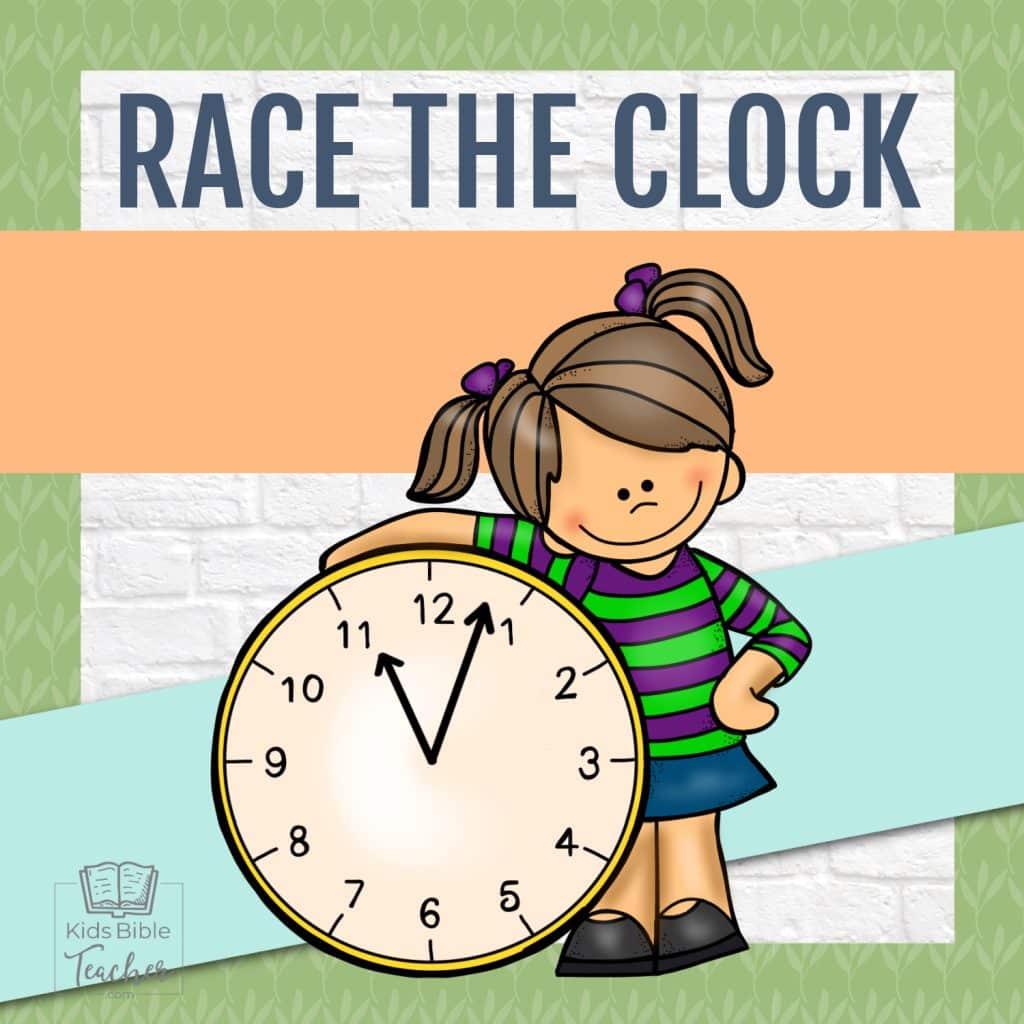
2. Race the Clock Sunday School Games
Ages: 3rd grade and up
Materials Needed:
- List of questions
- A timer (such as a timer on a cell phone)
Set Up: None.
To Play: Choose one student to watch the timer. Set the timer to 2 minutes. (If you have a lot of questions, you may need a longer timer. If you have just a few questions, choose a shorter time.)
When everyone is ready, have the student start the timer and say “Start!”
Immediately ask the students the first question and then say, “Go!” Students CANNOT interupt the teacher and answer the question before you say “Go!”
When you say, “Go!”, anyone in the class can blurt out the answer. If the student answers correctly, you will immediately begin asking the next question, followed by “Go!”. The students can talk among themselves before answering, if desired.
If the student answers incorrectly, you will say “Stop!” and the person holding the stop watch will count down 5 seconds. During those five seconds, no one is allowed to speak. At the end of 5 seconds, you will repeat the question and say “Go” again. The students can then answer the question correctly.
If the class does not get through all of the questions in the designated time, play the game again using the same questions. See how much faster the students are now that they have heard the answers once. The only obstacle? If they get the answer wrong during this round, 10 seconds are counted off before they can answer again.
Reward the class with a sweet treat if they beat the clock!
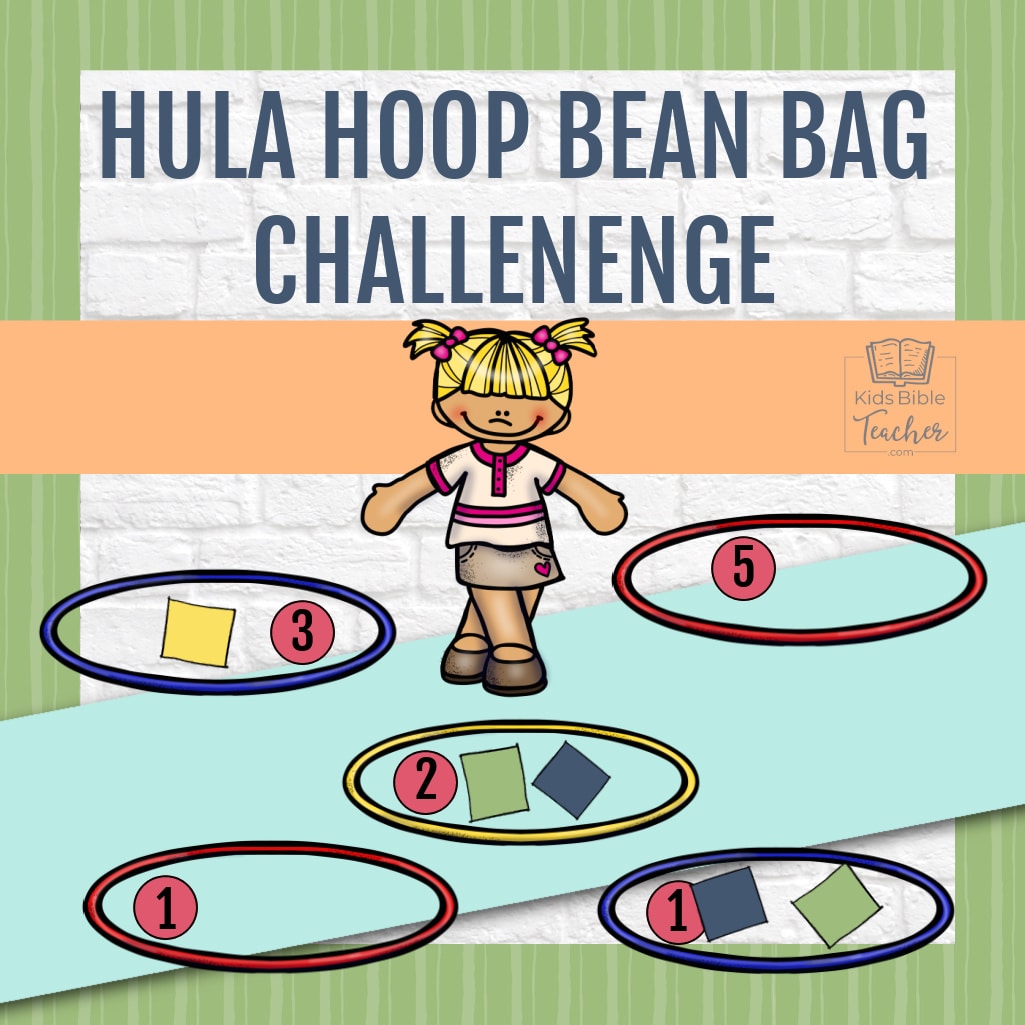
3. Hula Hoop Bean Bag Challenge Bible Lesson Game
Ages: Preschool and up
Materials Needed:
- List of Questions
- 5-7 Hula Hoops (Can often be found at the Dollar Store)
- Point Cards (Get printable Animal Point Cards for FREE when you sign up for the 12 Bible Lesson Review Games Printables!)
- Small Bean Bags
Set up: Place the hula hoops on the floor. Mark a “start line” for the kids to throw from. (If your kids are young, place the hula hoops fairly close together, and close to the start line. If your students are older, move the hula hoops farther apart and farther from the start line.) Place one Point Card inside of each hula hoop or ring.
To Play: Divide the class into two or more teams. Give each team the same number of bean bags. Ask the teams questions, alternating between teams. When someone answers a question correctly, they will stand at the start line and throw the bean bag into a hula hoop. If they get their bean bag into a hula hoop, their team is awarded the number of points indicated on the Point Card.
If you have a couple of students who like to answer ALL the questions, limit the number of times they can answer / throw OR encourage them to pick a teammate to throw after they have answered.
Variation for Young Children: Print several copies of the Animal Point Cards. Instead of having the teams compete for the point values on the cards, allow the teams to “catch” the animals in the hula hoops when they throw a bean bag into the hoop. This keeps Sunday School games less competitive. You may also want to give additional tries to young children.
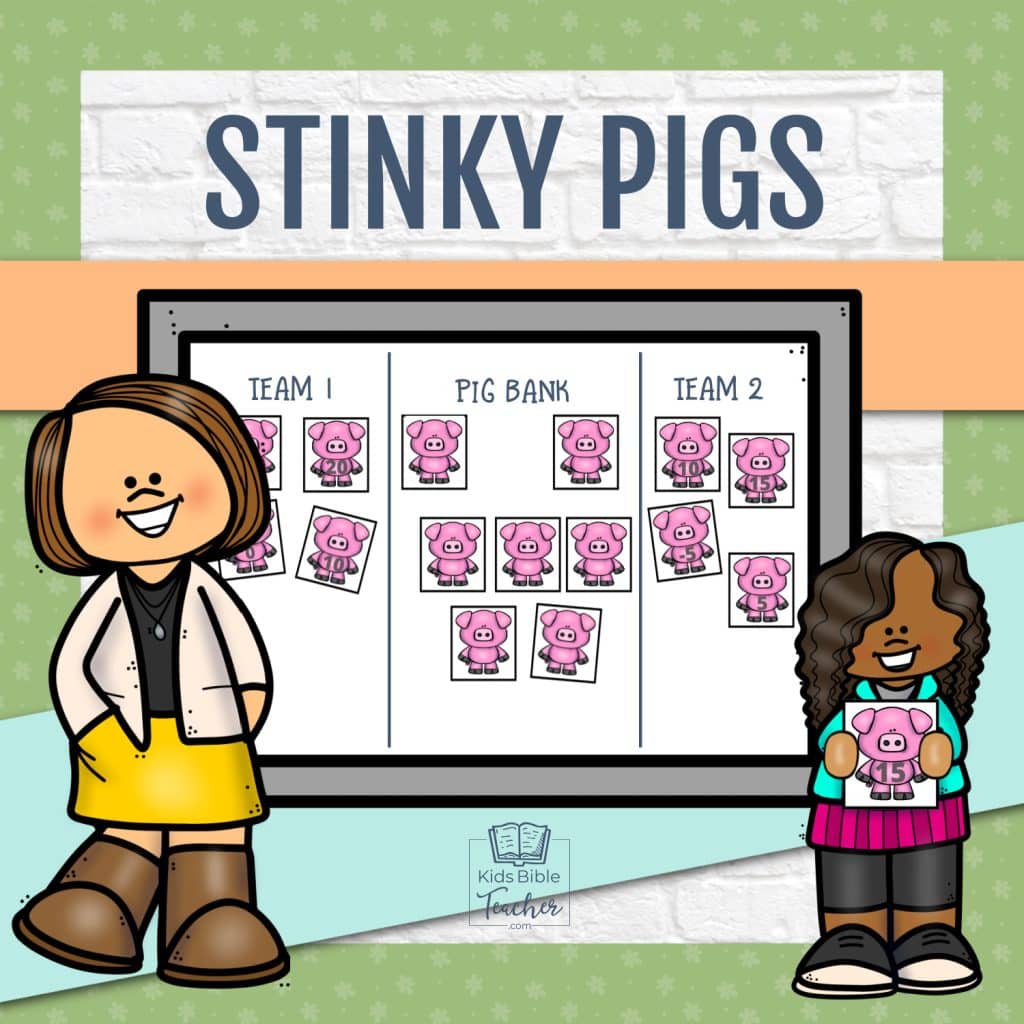
4. Stinky Pigs Bible Lesson Review Game
This is one of my students’ favorite Sunday School games!
Ages: 2nd Grade and Up
Materials Needed:
- List of review questions that corresponds with your Bible lesson
- “Stinky Pigs” point cards pages, printed double-sided (Get the printable “Stinky Pigs” pages for FREE when you sign up for the 12 Bible Lesson Review Games Printables!)
- Tape
- Dry Erase board and marker or chalkboard and chalk
- Items for challenges, if desired (bean bags and empty trashcan, etc.)
Set Up:
Cut the “Stinky Pigs” point cards out along the black lines. Tape the “Stinky Pigs” point cards in the middle of the dry erase or chalkboard, making sure that the point side is facing the board (hidden). (See the image below.)
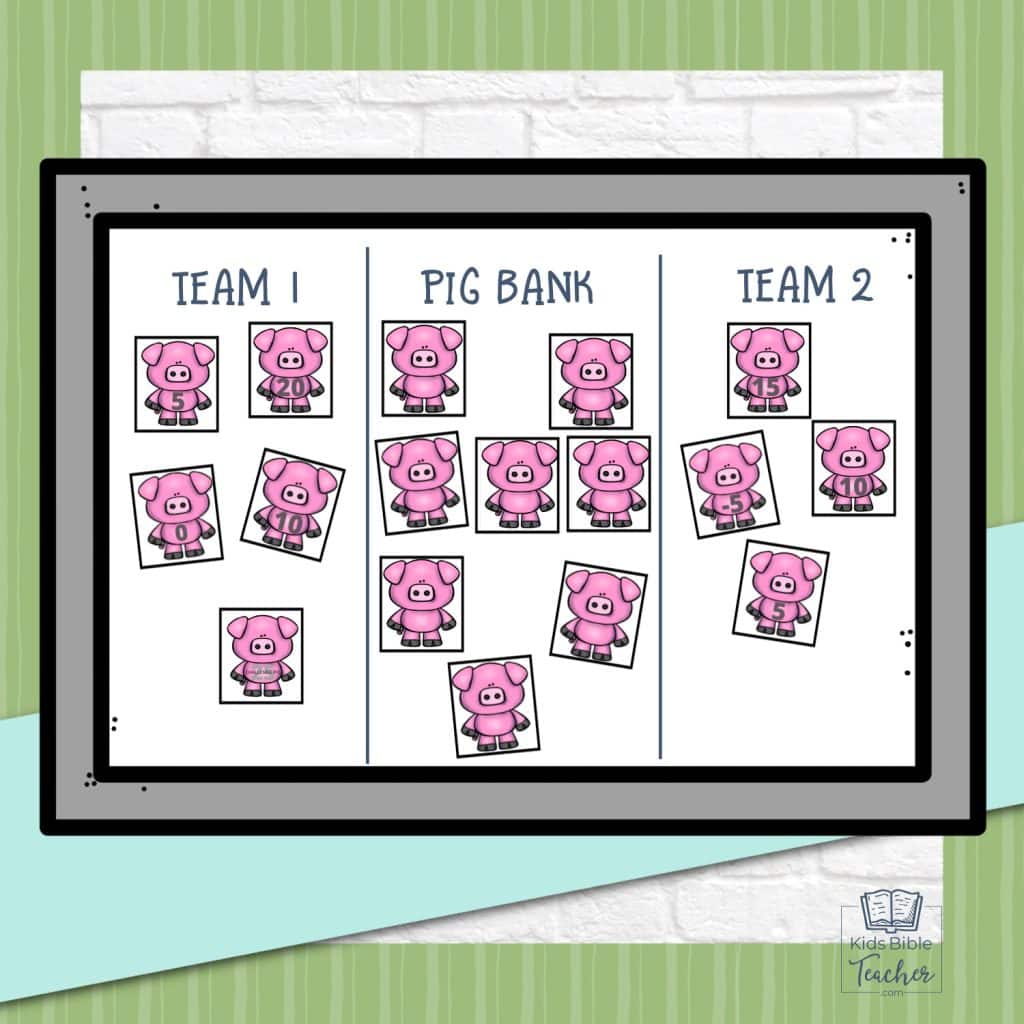
Draw a “team” column on each side of the board to keep track of each teams’ points.
To Play:
Split your students into two teams.
Ask “Team 1” a review question. If they answer correctly, they can choose any “stinky pig” from the “pig bank.” Be careful! Some “stinky pigs” are stinkier than other pigs and can actually take points away! Flip the pig over and tape it in “Team 1’s” point column.
Then, ask “Team 2” a quesion.
Repeat until all the stinky pigs are in the team columns or until the review quesions are done.
Add and subract the points in each team’s column. The team with the most points wins.
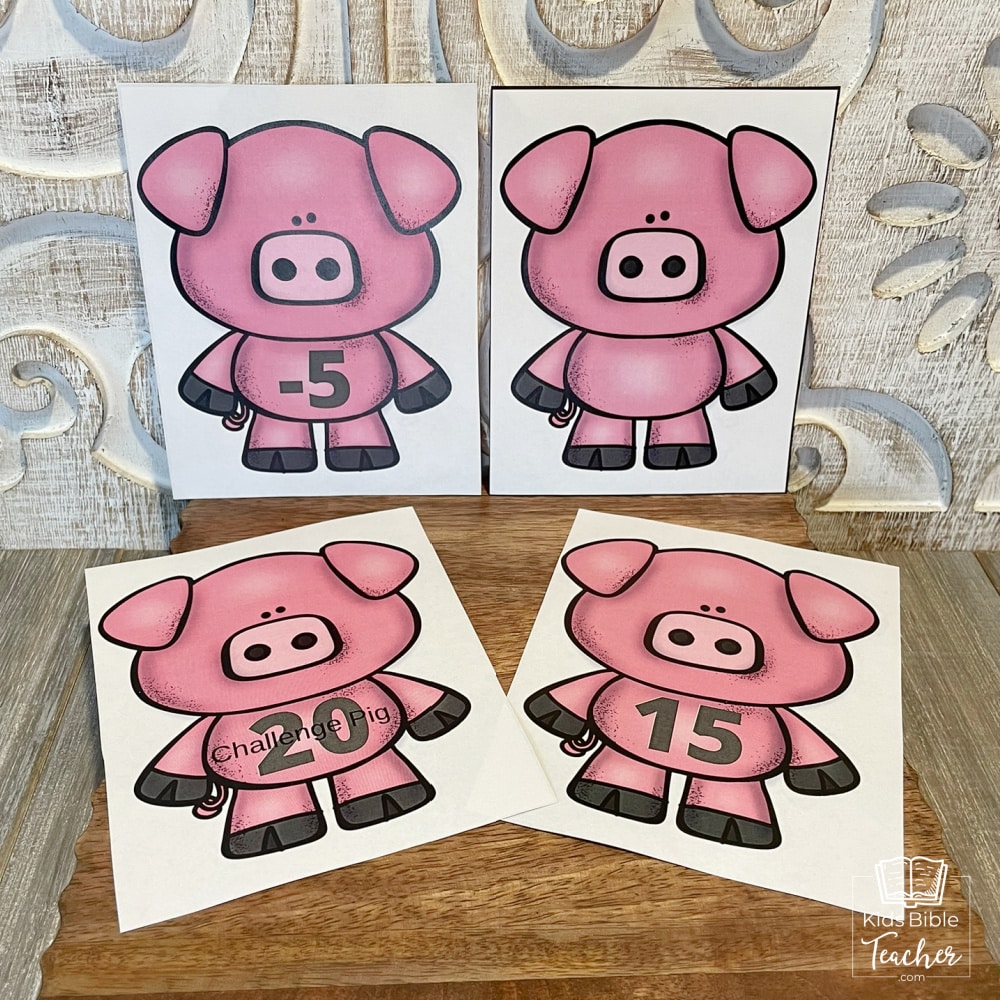
Variations:
Variation 1: If “Team 1” answers a question incorrectly, allow “Team 2” to answer the question. If they answer correctly, they move a stinky pig of their choice from THEIR points column to “TEAM 1’s” point column. (This allows Team 2 to get rid of a negative stinky pig. Here’s where strategy comes into play: If Team 2 has no negative pigs to get rid of, they may choose to purposely answer incorrectly so they don’t have to give any of their “good” pigs away. Let them figure this out on their own!)
Variation 2: Add a “teacher” column to the board. (FYI: The teacher will always lose.) If neither team can answer a question correctly, they each move one stinky pig of their choice to the teacher’s column. Alternatively, if neither team can answer a question correctly, the teacher can choose two pigs from the “pig bank”.
Variation 3: Add the “Challenge Pigs” to the Pig Bank. If a team flips over a “Challenge” stinky pig, they must compete with the other team to complete the challenge indicated by the teacher to get the number of points on the challenge pig. Challenge ideas: Which team can accurately say the memory verse the fastest without looking? Which team can throw the most balls into a trash can? Brought the most Bibles to church? Can write down the names of the first 5 books of the Bible first? Match the challenge questions to what your class has been learning.
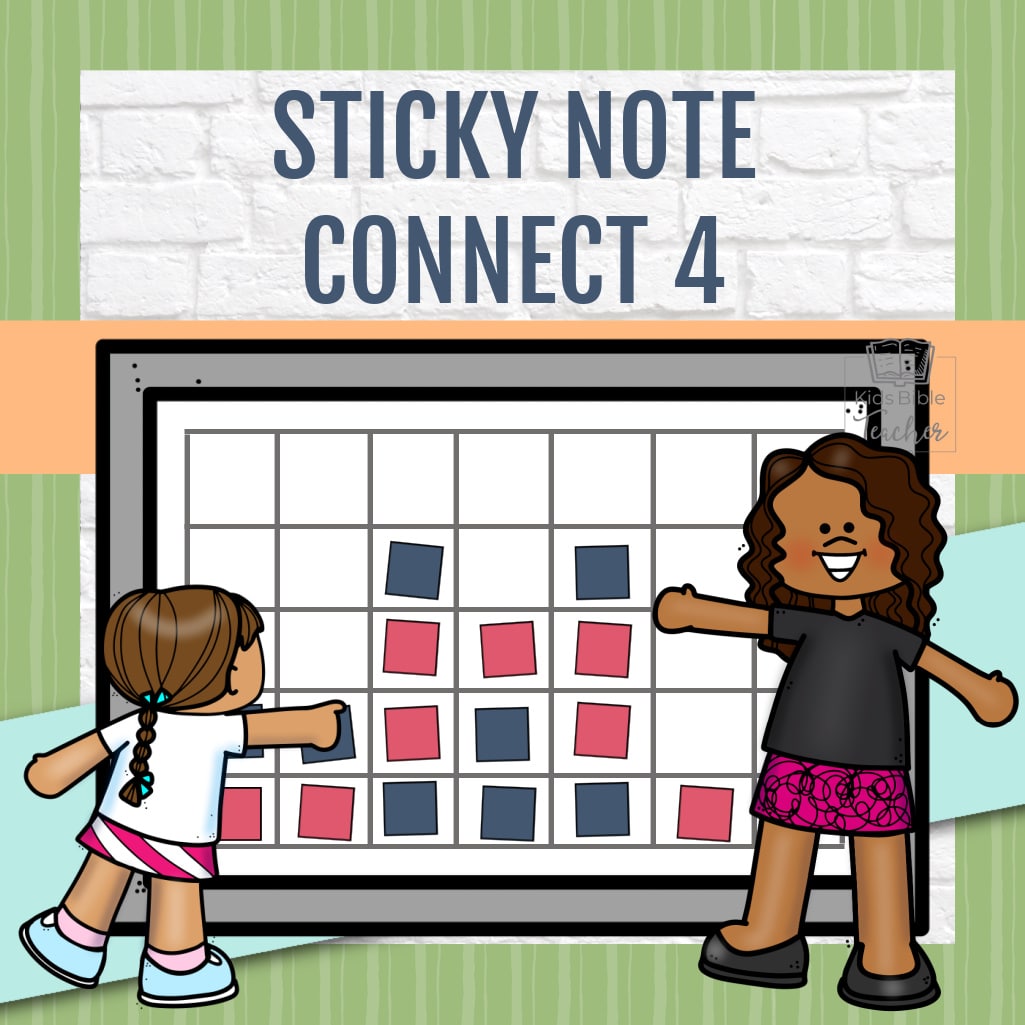
5. Sticky Note Connect 4 Sunday School Games
Ages: 1st Grade and Up
Materials Needed:
- List of Questions
- Large flat surface (such as a Chalkboard, dry erase board, poster board, or even a wall)
- Masking Tape
- Sticky notes or Paper circles or squares in two different colors
Set up: Using the masking tape, create a “grid” with seven columns and five rows on your flat surface. (See the image above.)
To Play: Divide the class into two teams. Ask each team a question, alternating between the teams. If they get the answer right, one person from that team can take a sticky note or colored paper circle or square and put it on the box of their choice on the grid. However, within a column, you can only fill the grid from the bottom up, stacking squares on top of each other rather than allowing them to “float” with nothing beneath them. It is then the next team’s turn. The first team to get four squares in a row (vertically, horizontally, or diagonally) wins!
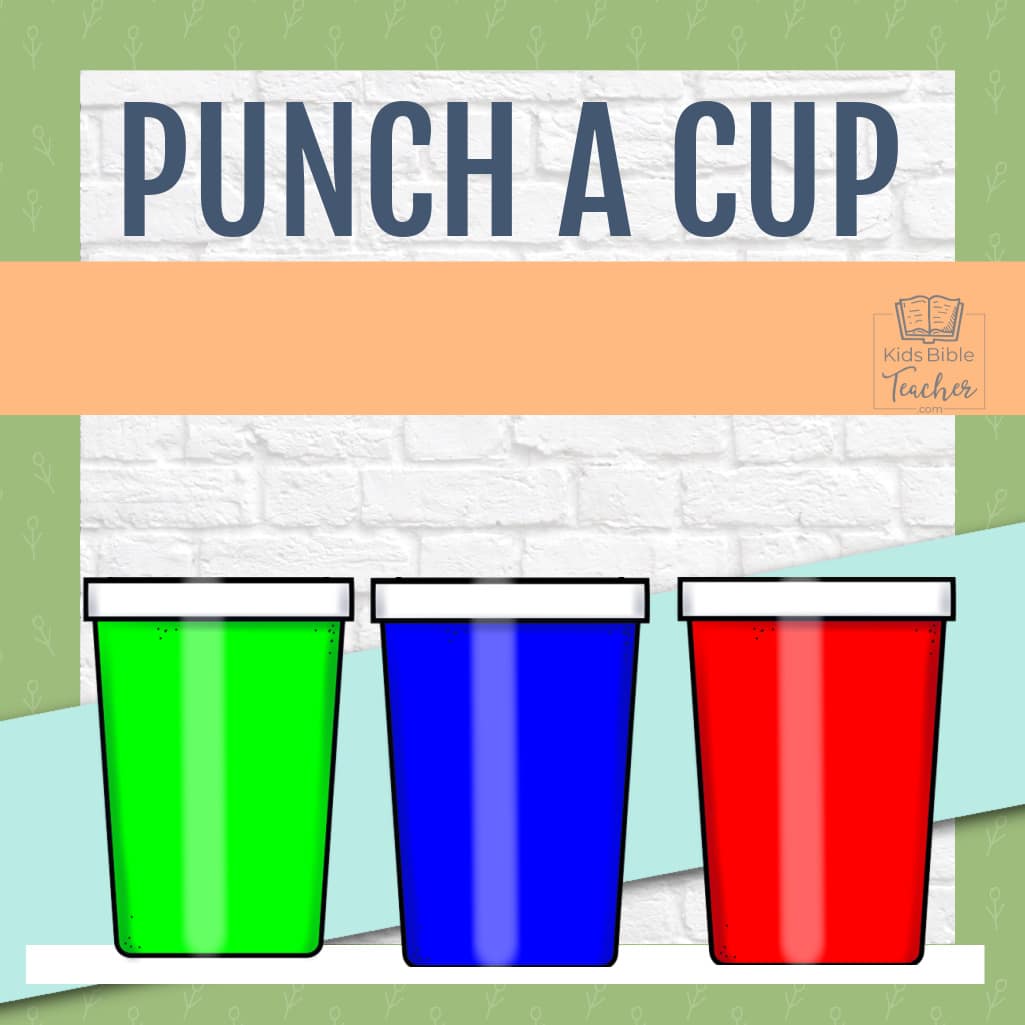
6. Punch a Cup Classroom Review Game
Ages: Preschool and up
Materials Needed:
- Large Poster Board
- 20 Large Plastic Cups
- Hot Glue Gun
- Tissue paper cut into 20 squares larger than the mouths of the cups
- Small Treats (Such as mints or wrapped candy)
- Rubber Bands wide enough to stretch around the mouths of the cups
- Optional – Point Cards for Variation 2 (Get printable point cards for FREE when you sign up for the 12 Bible Lesson Review Games Printables!)
Set up: Arrange 20 cups, bottom down, on the poster board. Glue the bottoms of the cups to the poster board with the hot glue gun. Place a small treat inside each cup. Cover the mouth of each cup with the tissue paper. Secure the tissue paper over the top of each cup by placing a rubber band around the tissue paper and the cup.
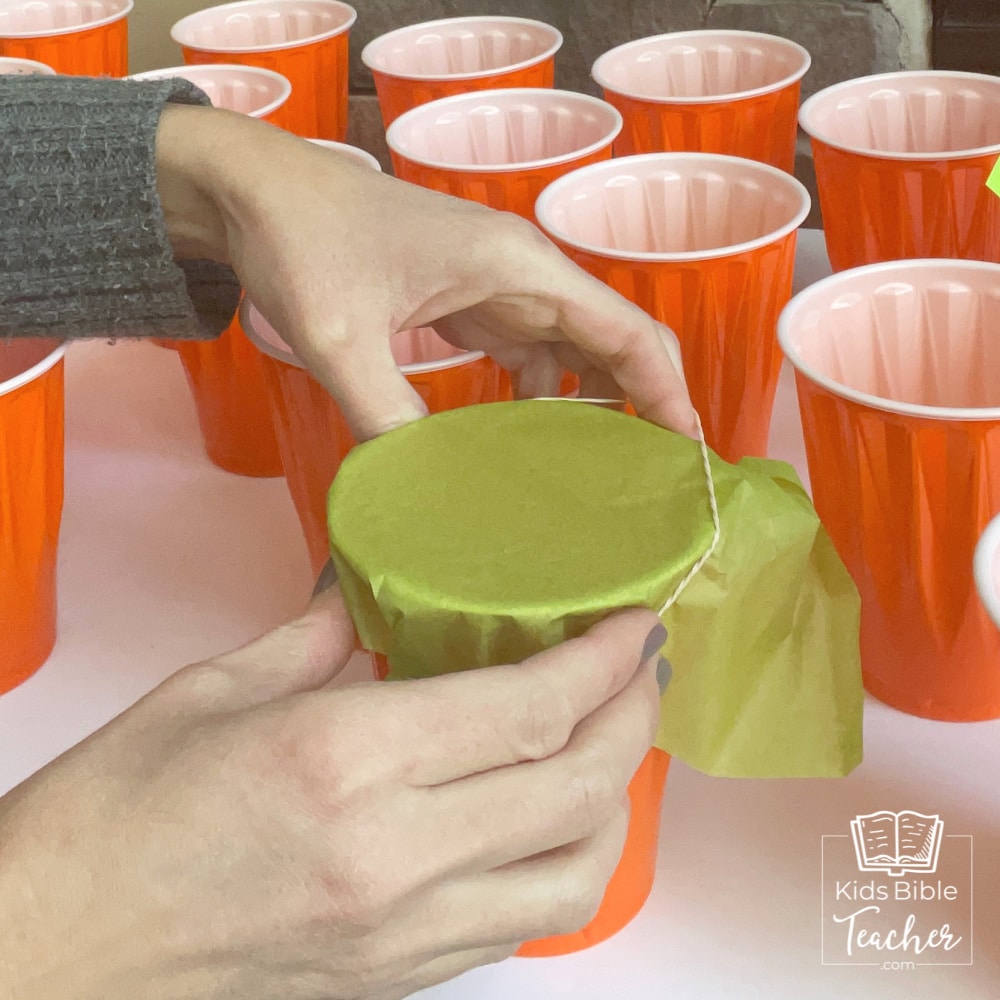
To Play: Ask your students questions. When someone answers a question correctly, they may come to the front and “punch” the paper tissue on one cup to get the prize on the inside.
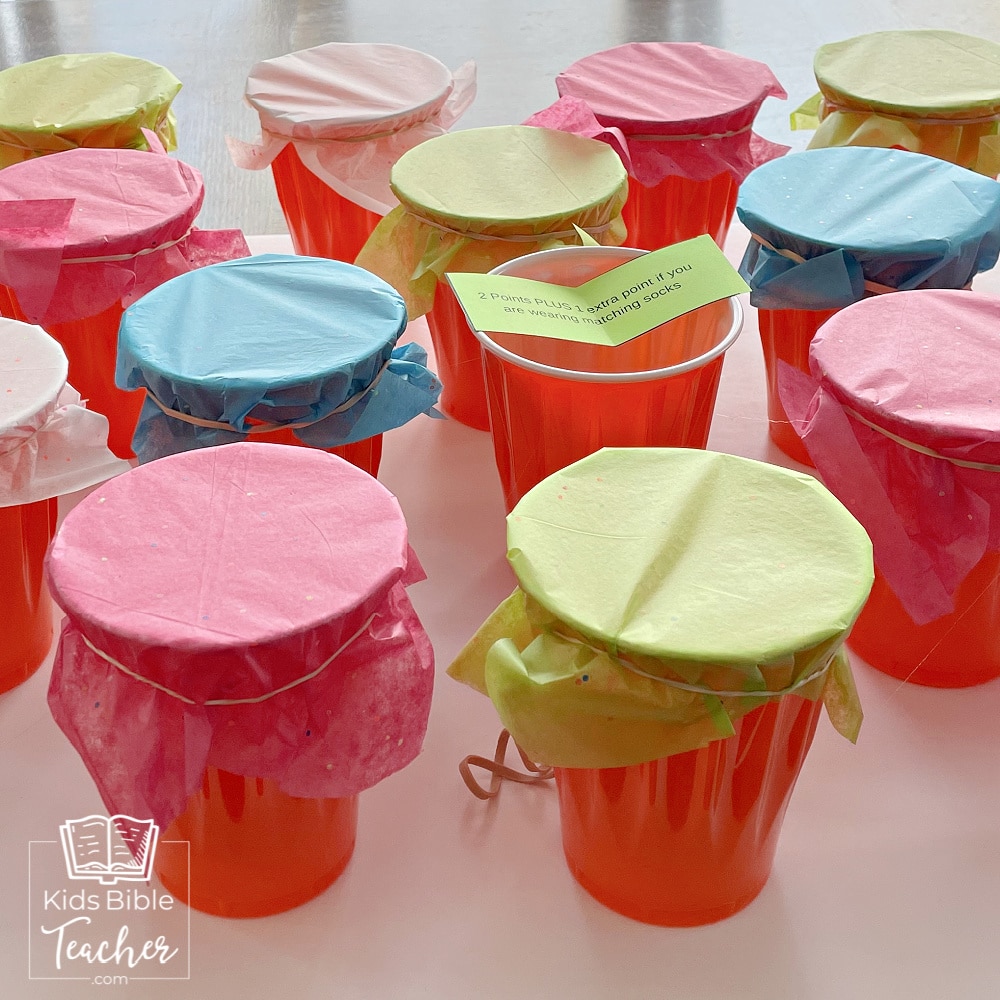
Punch a Cup Sunday School Games Variations:
Variation 1: Print your Bible lesson questions on a piece of paper, cut the questions apart, and place a question in each cup before covering it with tissue paper. Divide your class into teams. Alternating between teams, have one person from each team come up, punch a cup, withdraw the question, and attempt to answer it. You could also include cups with prizes or “free points”. This variation is best for kids who can read well.
Variation 2: Print point cards on two different colors of paper. Put the point cards into the cups. (It’s ok if you don’t use all the point cards, but use the same point cards for both teams.) Cover the cups with two different colors of tissue paper, one color for each team. When a team answers a question correctly, one person gets to come up and punch a cup with their team color to see how many points their team gets. To make this even more fun, include one “Surprise!” sweet treat cup filled with small candies for everyone on the team.
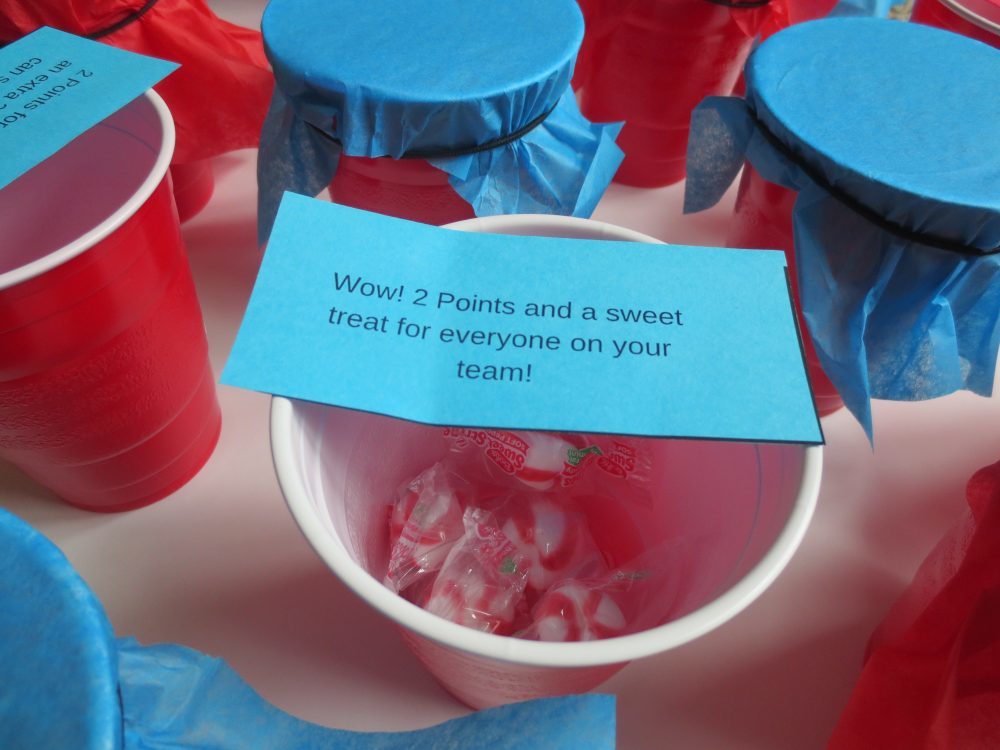
Once you make the Punch-A-Cup board, reuse it for other lessons by refilling the cups and placing fresh tissue paper over the cups.
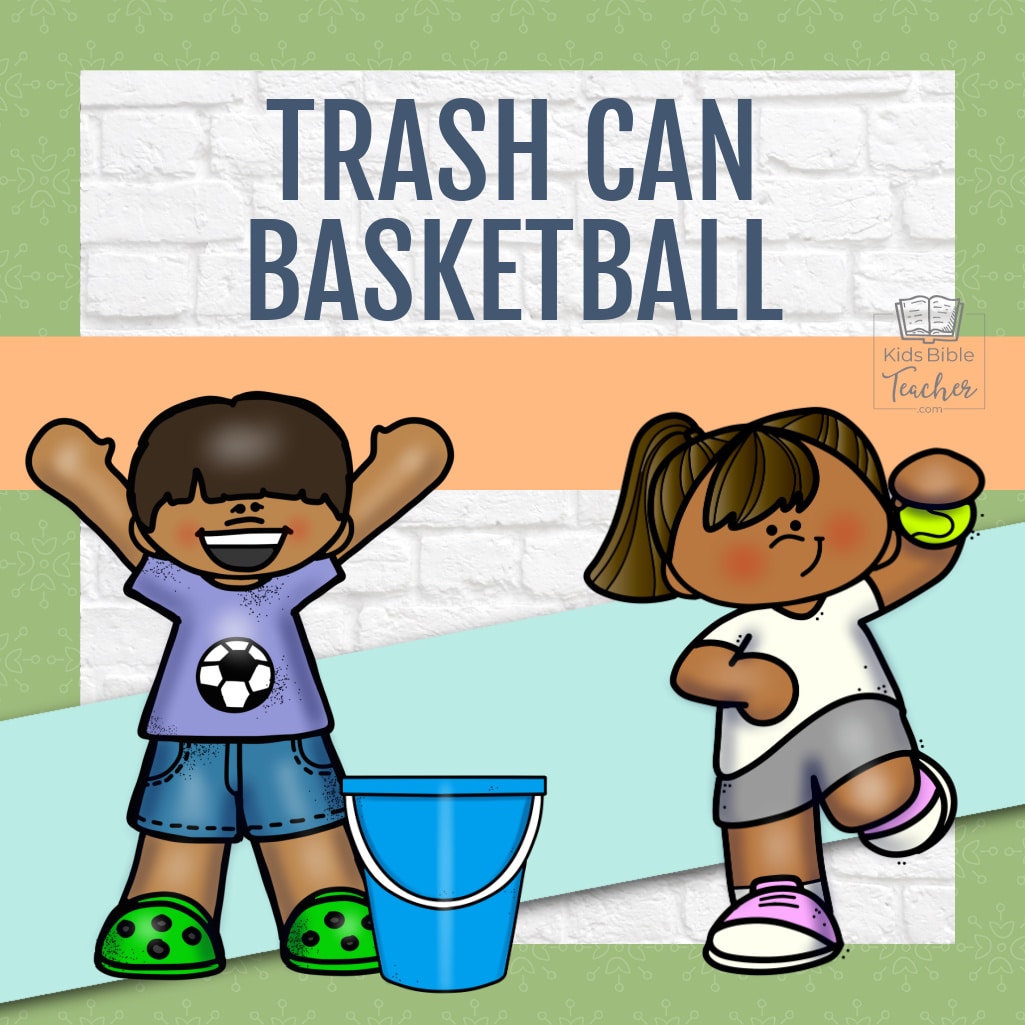
7. Trash Can Basketball Sunday School Games
Ages: Preschool and up
Materials Needed:
- List of Review Questions from your Bible Lesson
- Small, soft ball OR bean bag
- Relatively clean, empty trash can or large basket or bucket
- Masking Tape or String (or random piece of paper) to mark “throw” line
Set Up:
Place the trash can in a central location. Step away from the trash and try throwing the ball or bean bag into the trash can. When you are at a good distance to make it challenging but not too hard for your kids to score a “basket”, place a piece of masking tape, string, or paper for a “throw” line.
To Play:
- Divide your students into two or more teams. Line the students up by team, facing the basket, with the first person on the team facing the basket and the other students on his or her team standing behind him or her.
- Ask “Team 1” a question. If they answer it correctly, the front person from that team gets three chances to score points by throwing the ball into the basket (they could score 3 points if they make 3 “baskets”.) Then, they head to the back of the line.
- Then ask “Team 2” a question. Continue alternating questions between teams.
- Continue play until the questions are finished, then tally the scores to find out which team won.
Large class? Have the first three students on each team throw one time instead of having one student throw three times. This will help to make sure that everyone gets a chance to participate.
Note: If you have very young kids, a laundry basket or toy bin might make an easier target than a trash can.
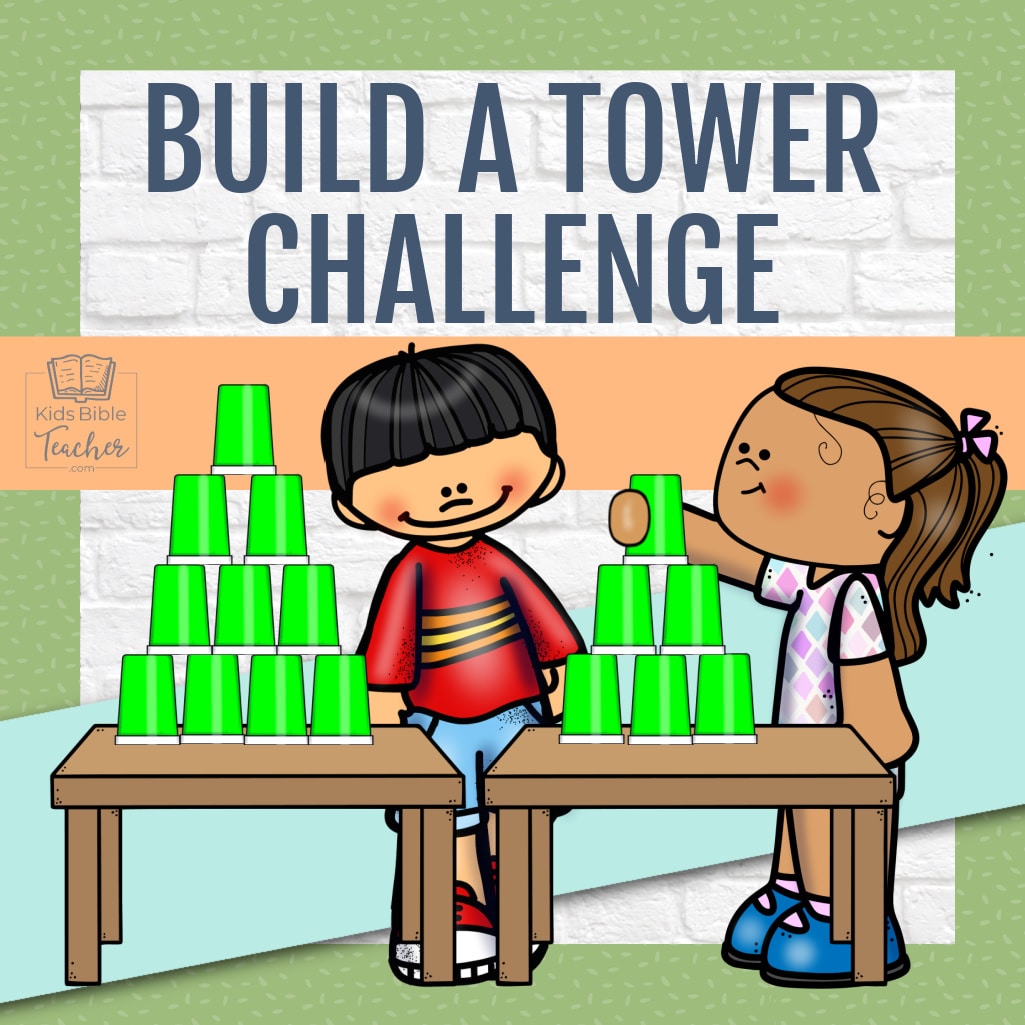
8. Build a Tower Challenge Sunday School Games
Ages: 1st Grade and up
Materials Needed:
- Styrofoam or Plastic Cups
- Table or Large Flat Surface
- List of Questions
Set Up: Have the table and Styrofoam cups ready to go.

To Play: The object of this game is to see which team can build the highest tower before the cups come tumbling down!
Divide your students into two or more teams. Ask each team a question, alternating between teams.
When a team answers a question correctly, a member of that team may take a cup and place it on the table or on top of another cup to build their team’s “tower”. They can place the cups as part of the foundation, right side up, or upside down – however they think best to build their team’s tower.
If you don’t have a long list of questions or if you want this game to move along more quickly, allow your students to place 3-5 cups for each question answered correctly.
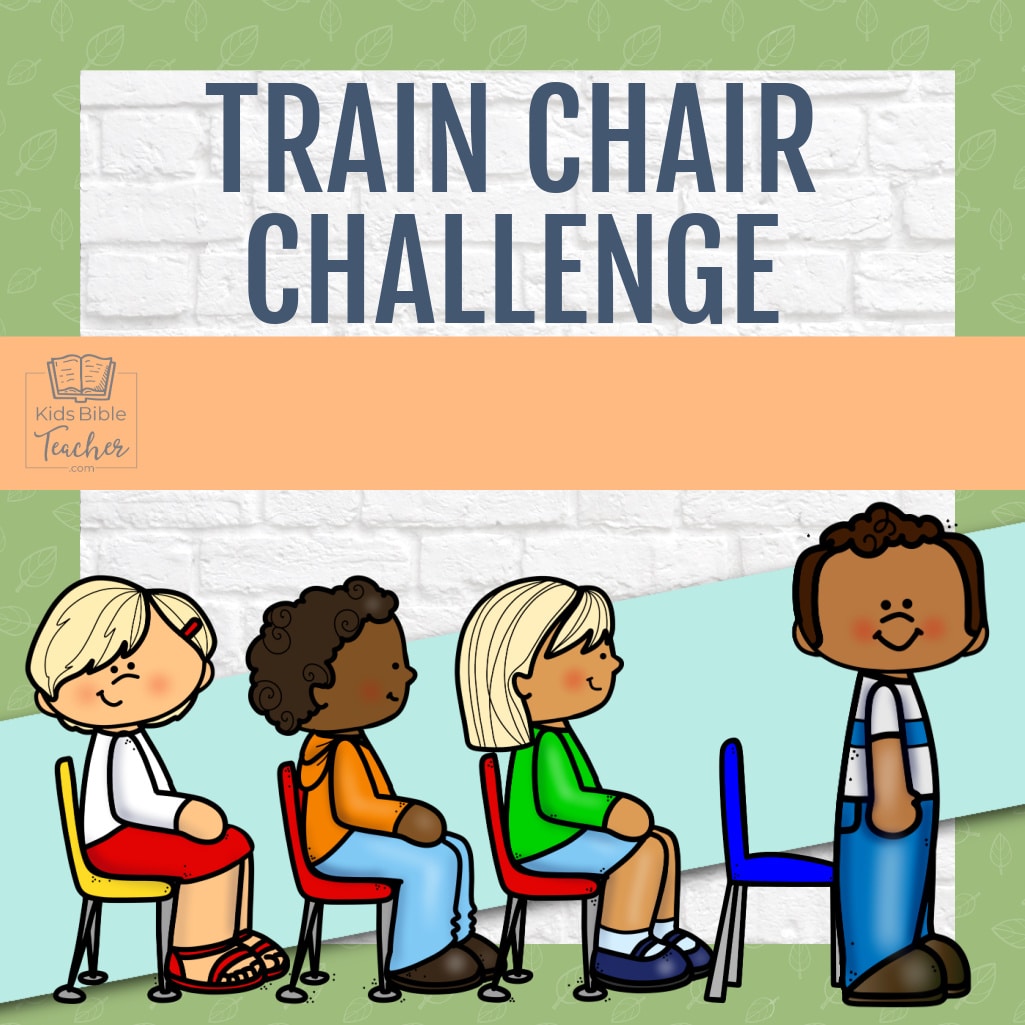
9. Train Chair Challenge Classroom Game
Ages: Preschool and Up
Materials:
- List of Review Questions from your Bible Lesson
- A chair for each student
Set Up: Arrange two rows of chairs, each chair facing forward (like a train), one chair for each student.
To Play:
- Divide the students into two teams. Have one team sit in one row of chairs and the other team sit in the other row of chairs. Let the kids know that they need to be listening for a particular phrase. Whenever they hear this phrase, the first person to say “Train Chair Challenge” will get an extra point for their team. (You could use a funny phrase, a short part of a verse the class is memorizing, or a point you want them to remember.)
- In this challenge, only the two people sitting in the front chairs may answer a question. Ask the question, then say “go.” The first of the two front students to stand up may answer the question. He or she then gets one point for his or her team for the correct answer. If the student stands but is unable to answer the question, the other student gets a chance to answer correctly and get the point. If neither can answer correctly, no points are given.
- Once the question is answered, both students from the front chairs go to the back chairs and all students move up one chair.
- Ask the next question to the new students in the front seats and continue playing the game.
- As you ask the questions, occasionally say, “Remember, (insert your phrase).” First person to yell “Train Chair Challenge” gets an additional point for their team.
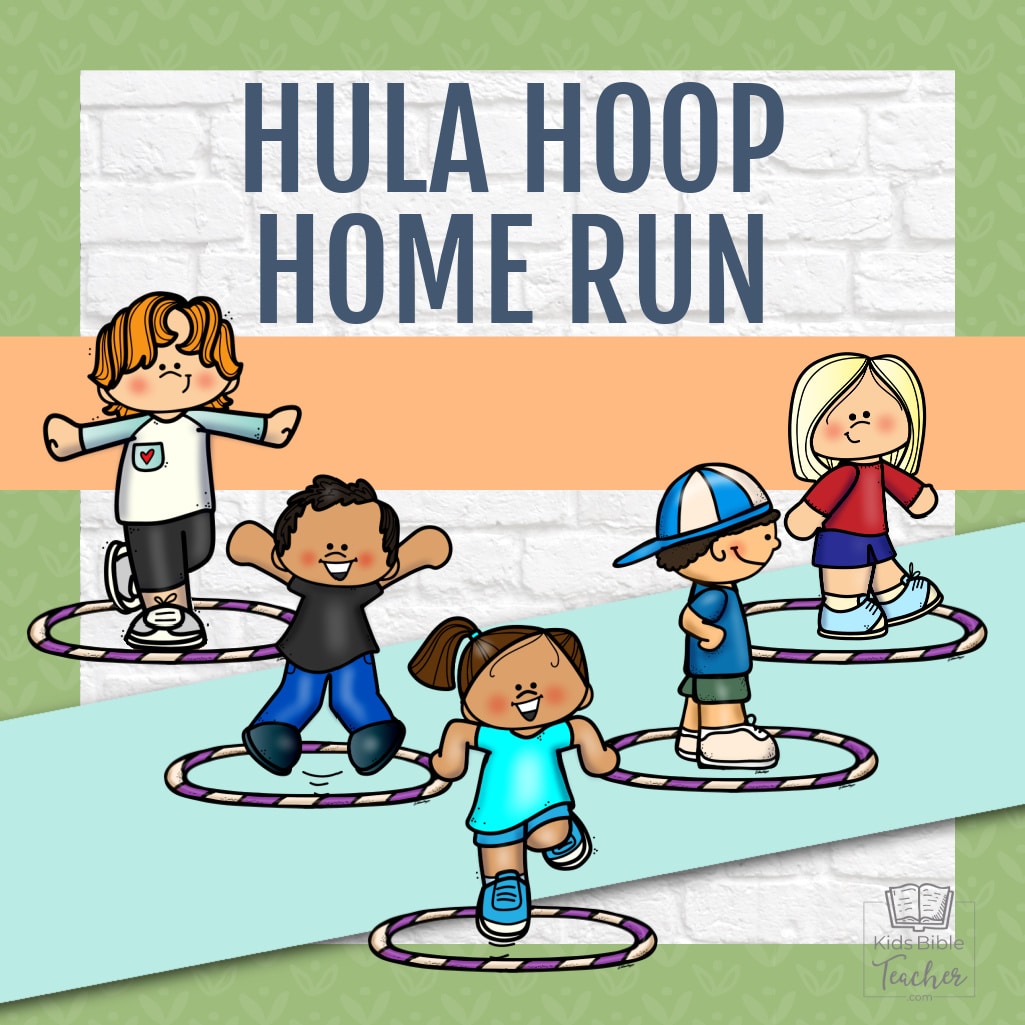
10. Hula Hoop Home Run Bible Lesson Game
Ages: 2nd Grade and Up
Materials:
- 6 Hula Hoops (Can often be found at the Dollar Store!)
- List of Challenging Review Questions from your Bible Lesson (For example, “Name 8 of Jesus’ Disciples” or “Say today’s memory verse” rather than “Was Peter a disciple?”)
- 2 Pieces of Masking Tape, String, or 2 Random Pieces of Paper for two “Start” lines
Set Up:
- Create a Hula Hoop course by placing the hula hoops in a meandering line. Stagger them so that kids can jump from hula hoop to hula hoop.
- Place a “Start” line at the beginning of the hula hoop course.
To Play:
Divide the students into two teams. Have “Team 1” stand in a line at the start line, with the first person facing the hula hoops. You will ask “Team 2” a question, then say “Go”. “Team 2” will try to answer the question as quickly as possible. Meanwhile, “Team 1” will jump from Hula Hoop to Hula Hoop trying to get as many people through the Hula Hoop course as possible.
Only one person can be in a single Hula Hoop at a time. As soon as the first person has jumped out of the first Hula Hoop, the second person may jump into the first Hula Hoop.
As soon as “Team 2” correctly answers the question, the teacher calls “stop”. “Team 1” will get one point for every person who crossed the finish line before the teacher called “stop”.
The next question is given to “Team 1” and “Team 2” will try to get people through the course before “Team 1” correctly answers the question.
Variation: For a harder challenge, alternate the way the kids jump through the hual hoops – one foot at a time alternating feet, or “bunny hopping” with both feet at once, etc.
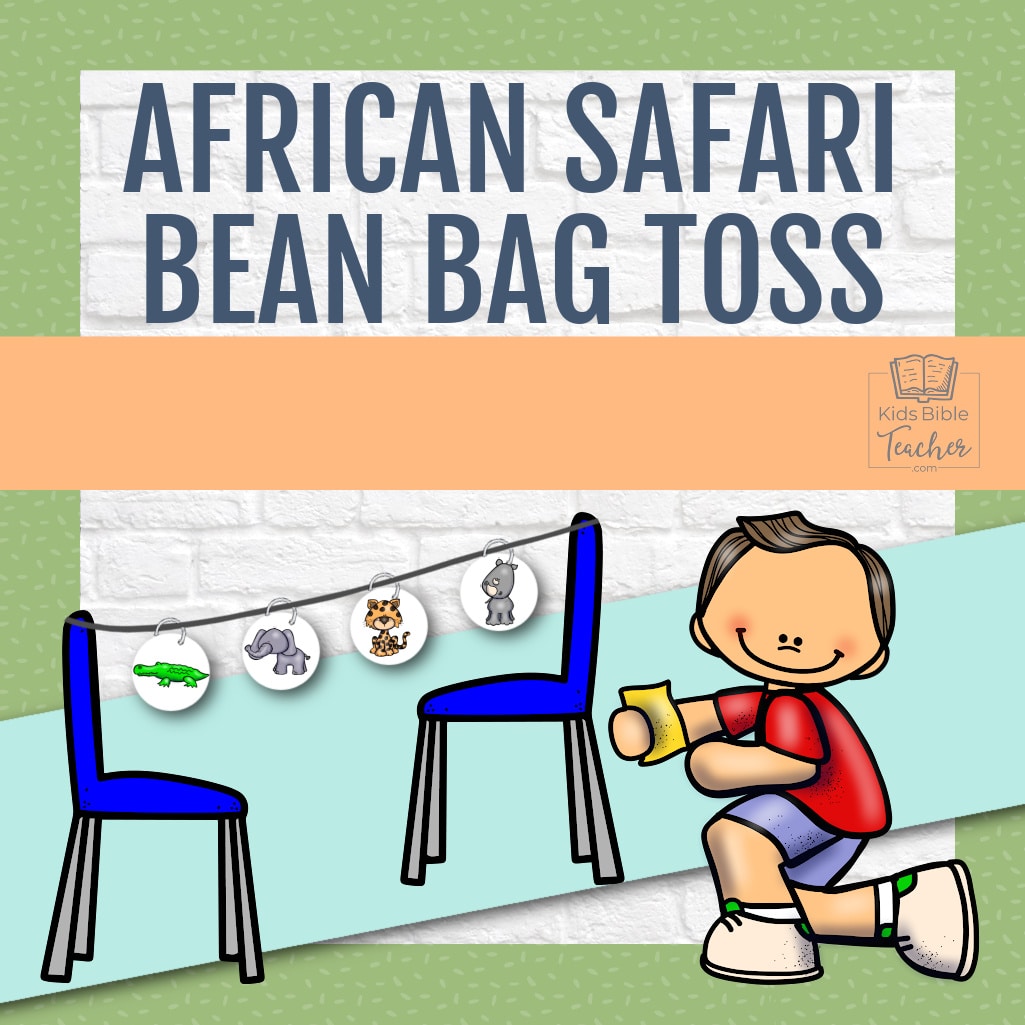
11. African Safari Bean Bag Toss Bible Lesson Review Game
Ages: Preschool and Up
Materials Needed:
- A List of Questions that pertain to your lesson
- Three Bean Bags
- Masking Tape
- String or Twine
- 2 Chairs
- 1 Copy of the African Safari Animal Targets, cut out (Get your FREE copy of the printable targets by signing up for the 12 Bible Lesson Games Printables!)
- Binder Clips, Clothes Pins, or “S” hooks
- Something to Record Points (Dry Erase Board, Paper and Pencil, etc.)
Set Up:
Set the two chairs about two to four feet apart, backs facing each other. The farther apart the chairs, the more challenging this game will be. Tie the twine or string between the two chairs, in two levels. Hang the Animal Targets from the twine or string using the the binder clips, clothes pins, or “S” hooks. Hang four or five targets in each row.
Place a piece of masking tape a good distance from the “targets” so that it will be a bit of a challenge for your kids to hit the targets with a bean bag, but not too hard. (This will vary by age group.)
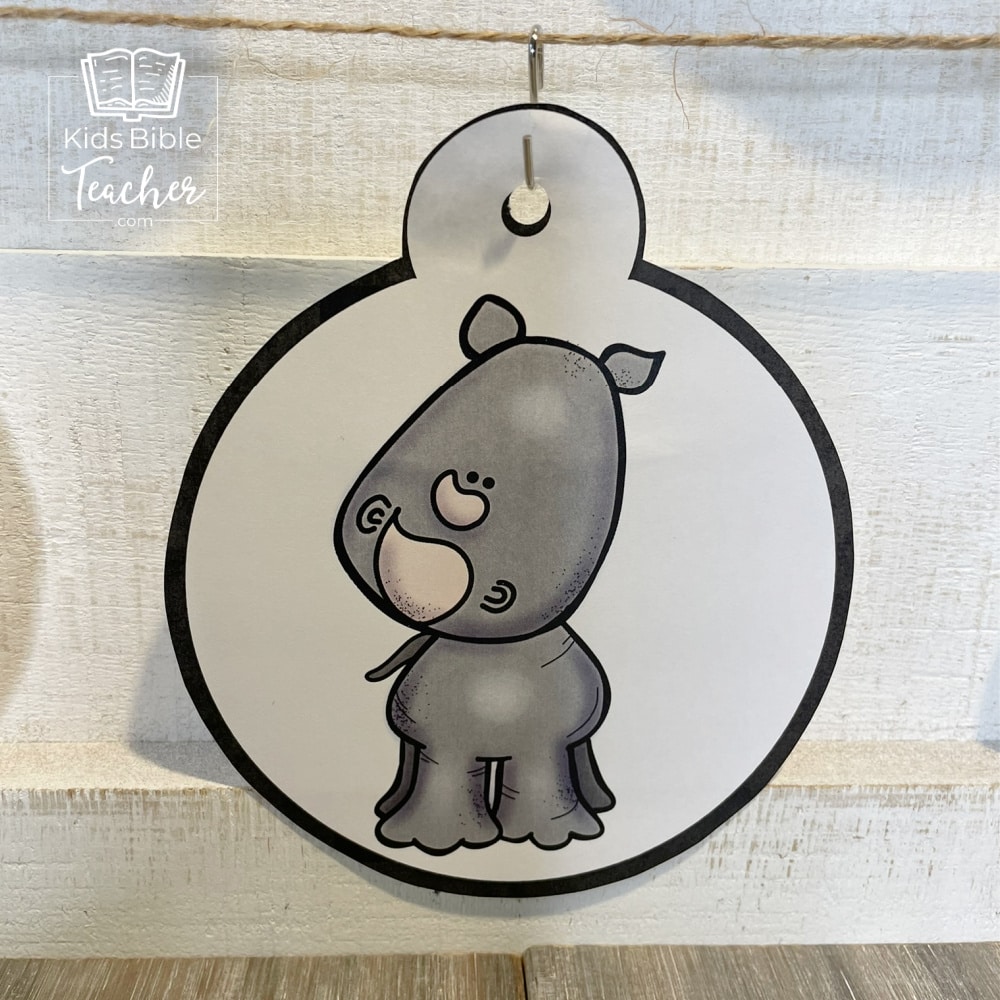
To Play:
Divide your students into two teams.
Ask team “A” a question. If they answer correctly, they get three shots at hitting the targets. Add up the number of targets that they hit and record it on a dry erase board, chalkboard, or a piece of paper.
Then, ask team “B” a question and give them three shots at the targets. You may have one student answer a question and throw three times to get up to three points, OR you many ask a team a question and allow three students from that team to each throw once if the team answers correctly.
Continue alternating questions and adding points to the score.

Note: This game should be fun and most students should be able to score points. If your students are having a hard time scoring points and seem frustrated, move the start line closer to the targets. You could also have the students throw a few shots before the game starts to make sure that your targets and the start line are reasonable.
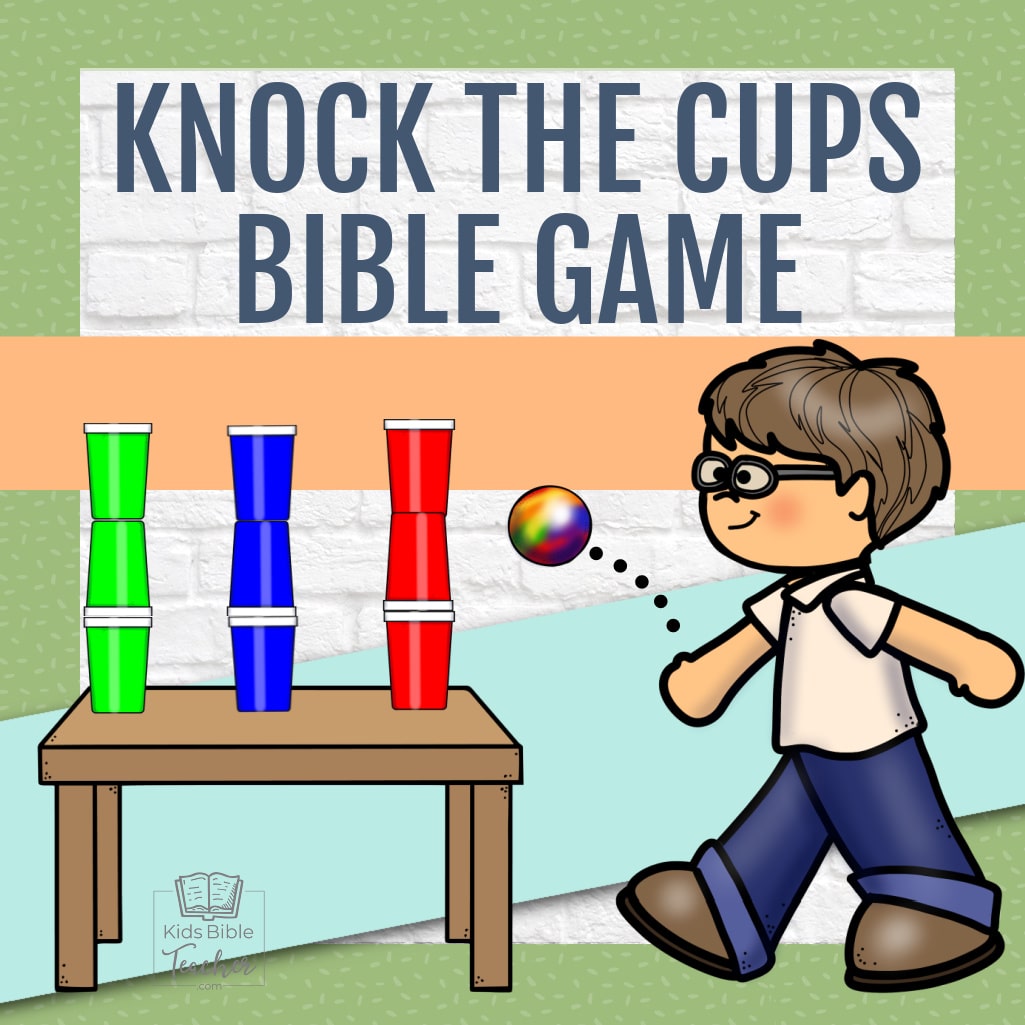
12. Knock the Cups Sunday School Game
Ages: Preschool and Up
Materials:
- Table
- 15 Styrofoam Cups
- 2 or more Bean Bags, Hacky Sacks, or small, soft Balls
- List of Review Questions from your Bible Lesson
- Masking Tape, String, or Random Piece of Paper for a “Throw” line
Set Up:
- Make a 3 cup “tower” on the table by placing a styrofoam cup upside down on the table. Place a cup right side up on top of it. Finish with a 3rd cup upside down on top. Make 5 of these towers, placed apart so kids can only hit one tower at a time. If desired, you make mark the top cup with different points so that some towers are worth more points than others.
- Place a “Throw” line on the floor at a good distance from the table so that the cups are challenging but not too hard for your students to hit with the bean bag or ball.
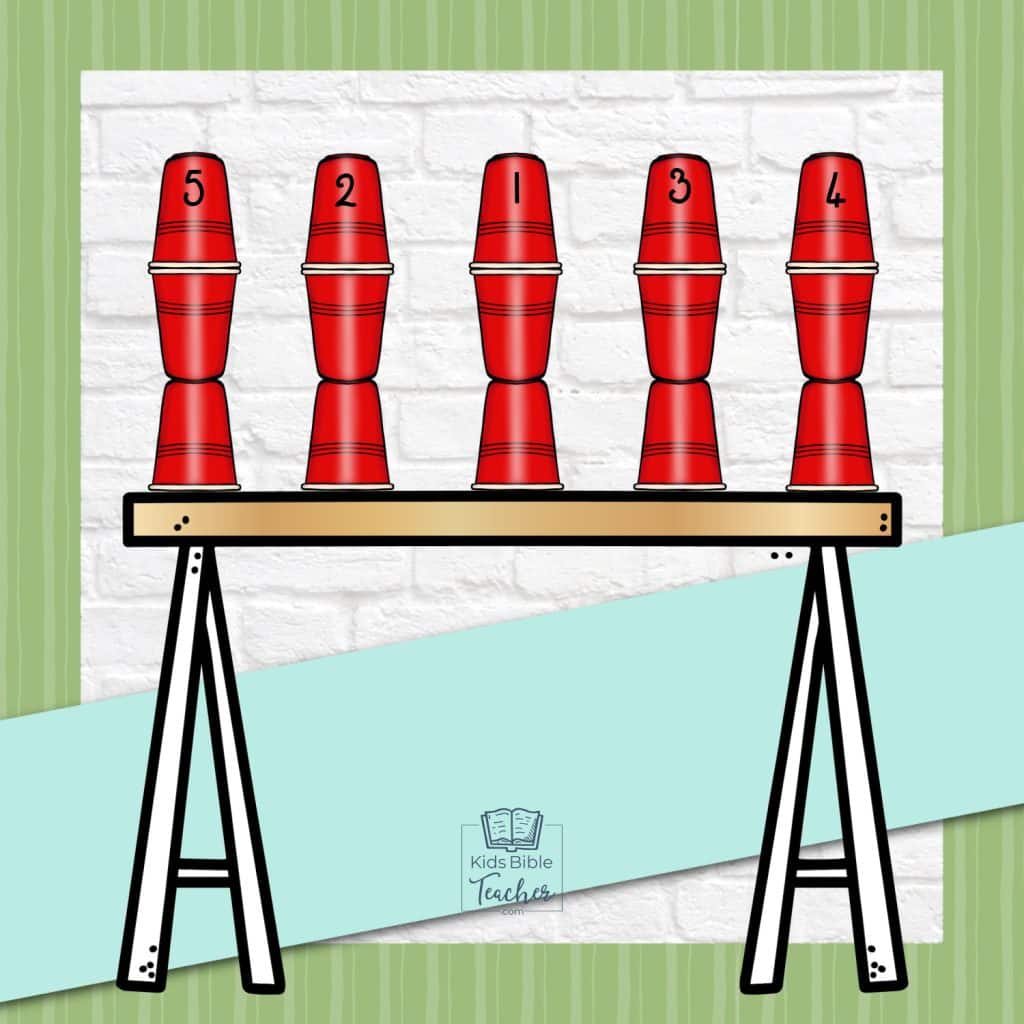
To Play:
- Divide your students into two or more teams. Have the teams stand in a line, with the first person in each line facing the cup towers.
- Ask “Team 1” a question. If the team answers the question correctly, the first person in line can throw a bean bag or ball three times, attempting to hit a cup tower. If he or she hits a tower, his or her team gets that number of points. After throwing three times, the front person moves to the back of the line.
- Then, ask “Team 2” a question and continue play.
Large class? Have the first three students on each team throw one time instead of having one student throw three times. This will help to make sure that everyone gets a chance to participate.
Tips for Sunday School Games:
Items to Always Keep On Hand:
Masking Tape, Twine, Balloons, and Bean Bags are great to always have on hand. Use the masking tape or twine to quickly make “start” and “finish” lines or to divide your room into two sections. If you ever run out of activities before you run out of time, you can always pull out the bean bags or balloons and play “Hot Potato”, “Monkey in the Middle”, or “Keep the balloon off the floor”.
Bean Bags: Don’t have multi colored bean bags? Write numbers on them with a sharpie marker, for “Team 1”, “Team 2”, etc. You could also draw color dots or shapes on the bean bags for younger kids.
Hula Hoops: Hula Hoops are another favorite Sunday School prop. They can be found at many Dollar Stores.
Point Cards: Many Sunday School Games require “point cards” to play. When you sign up for the 12 Bible Lesson Review Games printables (see bottom of this post or box at the left), you will get these adorable animal point cards – perfect to print, cut out, and even laminate if desired!

Ways to Help Students Participate in Bible Lesson Review Games:
Does one student answer all of your questions? Encourage other students to participate by asking them questions directly. Or, have a rule that each student can only answer once, to encourage more participation.
Do you have kids that HATE to be put on the spot and refuse to answer questions? Use “team” games where anyone on the team can answer a question. Allow only one person from each team to throw the bean bag (or whatever the activity), so that everyone gets a chance at the “fun” point scoring part.
For example, you ask a question and Sally answers. But, Sally has already answered and gotten a chance to throw the ball. Now, Sally must choose someone else on her team to throw the ball who hasn’t gotten a chance yet. Sally chooses Joey, a new boy who wouldn’t be able to answer a question from last week’s lesson. This method allows Joey to still participate and feel like a part of the team, even if he doesn’t know the answers to the questions.
Do you have any great Sunday school game ideas? I would love to hear your suggestions. Please scroll down to comment.

Excited to try some of these games with my preschool Sunday school class! Thank you for your help to make my class interesting with helps to keep engaged.
Thank you for giving me ideas for games for the preschoolers. I will try them out and see which games they like best. Loved how you gives tips too.
So thrilled for fresh ideas – thank you so much for generously sharing them with me, Di
thank you it helps a lot
They are very good for kids and they will it
Here are 12 super-fun, easy-prep Sunday school games your students will love.
Thank you for the games. God bless you!
These are some great games! Thank you!
Those are great ideas! Thanks!
Always looking for different games. Not so much preparation. I am so excited to get started, thank you so much .
Always looking for different games. Not so much preparation. I am so excited to get started, thank you so much .
these are super fun looking. I was looking for ideas and we haven’t done these yet so they will love this.
Thank you! Always looking for activities!!
I love the finger games download! Thank you so much! May God richly bless you!
Awesome games and easy to set up and play
Thanks, this was very helpful
Great games!
Thanks for your article. I have a combined class tomorrow, bringing in a teacher-less class. I was wanting to just let them have a fun game to play and found your site unexpectedly.
These are great for my class age, Ice Breaker before starting Lesson.
I love this website. It is great. I love the ideas – anything to get the kids attention and hold it!
Hi. These are wonderful. Thanks so much for sharing your ideas, can’t wait to try them out with the kids.
I found this post very useful and I’m so excited to try this to my students. Thank you so much for sharing this.God bless you..
Thanks so much for this Anna.
I’ve started running a kids church program during our Sunday service, we only have 12 kids at present but Looking forward to playing the games and making use of the memory games too.
I’m from Australia
You are so welcome, Jane. May God bless you as you minister to these precious kids!
I just found this site I read through the games. So excited to share them with my junior Church childre . Always looking for different games. Not so much preparation. I am so excited to get started, thank you so much .
These games look like fun, I hope my preteens will like them
Can’t wait to try them
These games are awesome . I am very so very thankful you sent them to me. I will use them in my Sunday School . I am sure the children will love doing them.
I just found this and feel so encouraged! So many games out there require a lot of prep and won’t do well with the kids in my jr high class. I KNOW they’ll love some of these, especially the arcade-style and the punch cups!
Thank you so much!! Loved this and helped me greatly!!
Oh, I am so glad it was useful. May God bless you, Tonda!